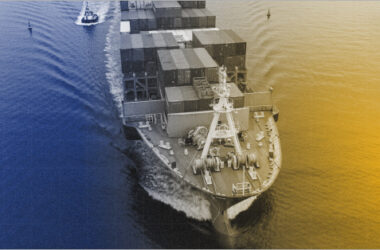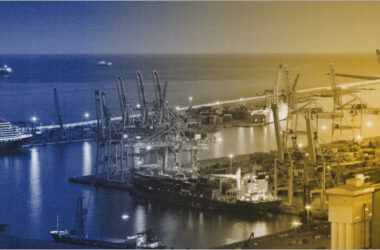Within the giant and complicated realm of international commerce, products worth billions of dollars cross oceans, skies, and borders daily. However, behind each container, each crate and each shipment, there is an important piece of paper, or, to be more exact, a legal document, which makes everything run smoothly: the Bill of Lading (BoL). It is not only a shipping receipt but an effective legal tool as well as a protection for buyers and sellers alike . Rather, it can be termed as the backbone of international logistics.
This blog goes into the depth of what a Bill of Lading actually is, how it operates, why it is important, and how it is still evolving in this digital age.
Definition:Bill of Lading
A Bill of Lading (BoL) is a legal document that is issued to a shipper by a carrier (a shipping line or freight company). It serves three important objectives–as a contract of carriage, a receipt of goods and a document of title.
Simply put, it confirms that goods have been shipped, declares the terms in which they will be transported and permits ownership of such goods to change hands during transit. The consumer of the services (the recipient of the shipment) makes use of the BoL to claim the delivery of the goods at the point where the shipment arrives.
It could be raw materials traveling between Mumbai and Rotterdam or finished electronics traveling between Chennai and Singapore, but a Bill of Lading is the final proof that the cargo is in safe and legitimate transit.
Bill of Lading : Historical Background and Evolution
The Bill of Lading has its origins in the medieval maritime trade where European merchants required documentation to show they had loaded their goods onto vessels. Initially, these were mere receipts. However, with the growth of international trade, the BoL turned into an elaborate legal text–accepted both in the courts and in financial institutions.
In the 21st century, the Electronic Bill of Lading (e-BoL) has been developed as a result of the digital transformation. Currently, carriers and ports are using digital versions of the paper, which enhance efficiency and minimize fraud. International Trade The International Chamber of Commerce (ICC) estimates that the global economic system of trade can save up to 6.5 billion a year with the widespread use of e-BoL.
Important Functions of Bills of Lading
The Bill of Lading has several important functions in international shipping. Here, we shall discuss its three primary functions:
- Evidence of a Contract of Carriage – The BoL provides evidence to show that there is a contract between a shipper and a carrier. It specifies the conditions under which the goods are going to be delivered, the freight rate, and the duties of the carrier.
- Receipt of Goods – It acknowledges that the carrier has accepted the goods in sound condition (or records any difference). This facilitates accountability in all levels of the supply chain.
- Document of Title – This is possibly the strongest feature- it represents ownership. Whoever is the holder of the BoL, he or she is entitled to the goods and thus it is critical in transactions conducted in Letters of Credit and international trade finance.
Such integrated capabilities render the Bill of Lading to be invaluable when it comes to reducing conflict, safeguarding the ownership rights, and providing transparency in logistics.
Different Types of Bill of Lading
Bills of Lading come in various forms depending on transport mode, negotiability, condition of goods, and type of carrier. Understanding the distinctions helps businesses choose the right one for their shipment.
A)Based on Mode of Transport
- Ocean Bill of Lading – Used for sea shipments; it can be negotiable or non-negotiable.
- Air Waybill – Used for air freight but is non-negotiable, as goods are delivered directly to the consignee.
- Rail/Road Consignment Note – Used for inland or domestic cargo transported via rail or road.
B)Based on Negotiability
- Negotiable (Order Bill of Lading) – Can be transferred to another party through endorsement, allowing ownership of goods to change hands during transit.
- Non-Negotiable (Straight Bill of Lading) – Issued directly to a named consignee and cannot be transferred to anyone else.
C)Based on Condition of Goods
- Clean Bill of Lading – States that the goods were received in perfect condition without damage or defect.
- Claused or Foul Bill of Lading – Indicates that goods were damaged or short in quantity at the time of loading.
D)Based on Carrier’s Involvement
- Master Bill of Lading – Issued by the main shipping line to the freight forwarder.
- House Bill of Lading – Issued by the freight forwarder to the shipper.
Each type plays a distinct role, and the choice often depends on trade terms, nature of goods, and financing arrangements.
Essential Components of a Bill of Lading
A typical Bill of Lading is more than just a piece of paper—it’s a detailed document containing crucial information. The following elements are usually included:
- Name and address of the shipper, consignee, and carrier
- Description of goods, including quantity, weight, and packaging details
- Port of loading and port of discharge
- Freight charges and terms of payment
- Date of issue and signature of the carrier’s authorized representative
- Special instructions or delivery terms (like “Freight Prepaid” or “Freight Collect”)
Accuracy in these details is critical. A single typographical error can lead to customs delays, insurance disputes, or even refusal of delivery at the destination port.
How Do Bills of Lading Function in International Shipping?
The process involving a Bill of Lading unfolds step by step:
- Goods Are Loaded – Once the cargo is loaded onto the vessel, the carrier issues the BoL to the shipper.
- Verification by Freight Forwarder – The freight forwarder ensures that shipment details match the booking and shipping instructions.
- Transfer to Buyer or Bank – The shipper sends the BoL to the buyer (or their bank, in case of a Letter of Credit transaction).
- Goods Released at Destination – The consignee presents the original BoL to the carrier at the destination port to claim the goods.
This systematic process ensures both transparency and trust between all trading parties.
Key Differences Between a Bill of Lading and Other Shipping Documents
While several documents accompany a shipment, the Bill of Lading stands apart due to its legal and ownership attributes.
- Air Waybill: Used in air transport but not a document of title.
- Sea Waybill: Similar to BoL but non-negotiable; goods are released only to the named consignee.
- Delivery Order: A separate instruction allowing release of goods, usually issued after surrender of the original BoL.
In essence, only the Bill of Lading can transfer ownership rights, making it a cornerstone in global commerce.
Why is the Bill of Lading Important in International Trade?
In global trade, where parties often operate across continents, the Bill of Lading provides structure and trust.
- It ensures ownership and custody of goods during shipment.
- It facilitates payment through banks under Letters of Credit.
- It protects against loss, damage, or fraud, offering legal recourse when disputes arise.
- It supports insurance and customs clearance processes, serving as an authentic record of shipment.
Therefore, international trade would be full of uncertainties and risks without a Bill of Lading.
Electronic Bill of Lading or e-BoL
The Electronic Bill of Lading (e-BoL) is changing logistics in an age when paperwork can potentially slow down international trade. An e-BoL performs the same role as its paper version – but electronically. It allows paperless and secure transactions between banks, shippers and carriers.
Advantages of e-BoL include:
- Quick exchange of documents and less delays.
- Reduction of courier and administrative expenses.
- Increases transparency and reduces the risk of forgery.
- Seamless compatibility with blockchain and smart contracts..
Nevertheless, the adoption of e-BoL continues to encounter challenges of whether it has been legalized in certain jurisdictions as well as cross-compatibility across the various digital mediums. However, of late, there has been a consistent shift of major shipping lines and trade networks towards a fully digital logistics ecosystem.
Typical Errors Associated with Bills of Lading
Although a Bill of Lading is important, it may be a point of disagreement when it is not handled properly. Common errors may include:
- Wrong consignee or shipper information.
- Incorrect description or weight of cargo.
- Late issue or surrender of the BoL.
To reduce these risks, companies must make sure that data is correct, employ verified freight forwarders, and look into the adoption of safe e-BoL platforms in terms of traceability and authenticity.
Legal Framework Governing the Bill of Lading
Several international conventions govern the use and legal implications of Bills of Lading:
- Hague Rules (1924): Established carrier liabilities and rights.
- Hague-Visby Rules (1968): Introduced modern amendments to carrier responsibilities.
- Hamburg Rules (1978): Focused on shipper protection and balanced liability clauses.
Bills of Lading are accepted in India under the Indian Bills of Lading Act, 1856 and are governed by international maritime laws and also by the Carriage of Goods by Sea Act, 1925. All these laws combine to make both shippers and carriers legally responsible in regards to their contractual duties.
Significance of Bill of Lading in Insurance and Claims
The BoL is a key participant in marine insurance. The insurers use the BoL as a guideline on liability and valuation of goods in case of damage, loss or delay.
An example is the Clean Bill of Lading, which shows that the goods were taken in an excellent condition- hence any damage discovered later must have happened during transit. It is taken as a form of baseline that insurers employ while determining claims, and at the same time , while allocating the responsibility between the shipper, carrier, and consignee.
Therefore, proper documentation will not only streamline claims but will also safeguard the financial interests of the insured.
Final Thoughts:
In international trade where commodities can be transported over thousands of miles with numerous middlemen, the Bill of Lading has become the lifeline of trust and legality. It has integrated shippers, carriers, insurers, and financiers into a single system which makes them responsible and transparent.
Whether you are a small exporter or a multinational logistics company, finding out how a Bill of Lading functions and making sure it is free of any errors can be the difference between a hustle free trade and an expensive disagreement.
It is true that, as the globe enters the digital age of trade documentation, the Bill of Lading is not going away–it is simply transforming. It is still one of the strongest documents in international business whether on paper or pixels.








